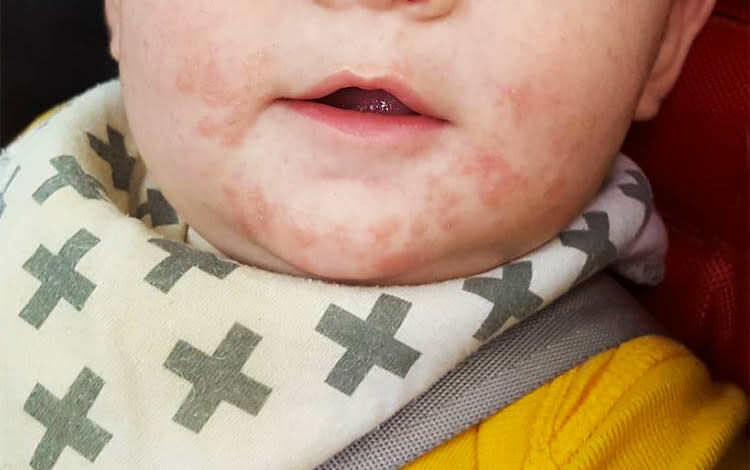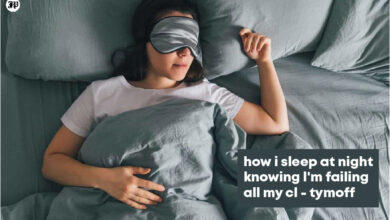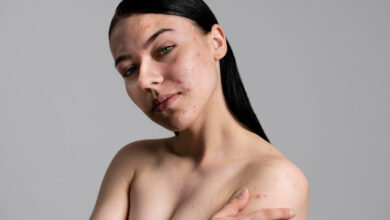Drool Rash vs Eczema: Effective Remedies for Both Conditions

Infants and toddlers often experience skin conditions due to their developing immune systems and sensitive skin. The two most common skin conditions parents encounter are drool rash and baby eczema. While drool rash and eczema may present similar physical appearance, such as irritated, red skin, distinguishing drool rash from eczema may require a thorough understanding of the causes and different approaches for effective management.
Understanding these skin conditions and implementing specific remedies is crucial for mitigating discomfort and promoting healthy, clear skin in young children. This guide entails effective treatments and remedies or cures for these skin conditions to help parents or caregivers provide the best possible care to the little ones.
Differentiating Drool Rash and Eczema in Infants and Toddlers
Identifying Drool Rash
Drool rash, or perioral dermatitis or irritant dermatitis, occurs due to excessive drooling around a baby’s mouth, chin, and neck. While this skin condition is widespread in teething infants due to increased or excessive salivation, it can also be experienced by infants under the teething stage. Excessive salivation breaks down the skin’s natural barrier, exposing the skin to excess moisture and causing irritation to the skin. Therefore, keeping the skin dry and gently wiping the drool can help prevent the baby from drooling.
Understanding Eczema
Eczema or atopic dermatitis is a chronic inflammatory skin condition characterized by dry, itchy, patchy, and inflamed skin. While it can be experienced by children of all ages, it is primarily prevalent in infants and toddlers due to their sensitive skin and growing immune systems. Eczema is often linked to external or environmental factors, and it can be exacerbated by triggers or allergens.
Prevention and Effective Management Tips for Drool Rash
Luckily, there are practical and viable solutions to manage and prevent babies from drool rash, ensuring their comfort. Here are some common top tips for keeping the baby’s skin happy and healthy;
- Gentle Cleaning of the Affected Area: Using lukewarm water, gently clean the affected area, and pat dry it to prevent moisture. Avoid rubbing or scrubbing, which can further cause irritation as babies have sensitive and developing skin.
- Apply Cream to Create a Thin Layer: Apply a non-burning, non-stinging, soothing, formula cream to soothe the baby’s skin and create a thin layer that can prevent excess moisture.
- Use a Gentle Wash: When bathing, use a mild, unscented soap that is made with only lye, water, and natural ingredients which are highly moisturizing and gentle on sensitive skin, avoiding any potential irritation.
- Keep the Skin Dry: Although it’s natural for babies to drool, one can minimize rash formation by keeping the baby’s face and clothing as dry as possible. Change their clothes when they become too wet, and gently clean their face after eating to remove drool. These practices will help prevent rashes from forming and keep the baby comfortable, ensuring safe and healthy skin.
- Avoid Irritants: Refraining from products containing harsh chemicals and ingredients, such as laundry detergents, lotions, and soaps, can help protect the baby’s skin from drool rash. Furthermore, opting for products that are fragrance-free can also help minimize the risk of irritation.
Prevention and Effective Management Tips for Eczema
Fortunately, there are practical and effective strategies to manage and prevent eczema in babies, ensuring their comfort. Here are some essential tips for maintaining the baby’s healthy skin and ensuring relief from discomfort:
- Consistent Moisturizing: Applying moisturizers to keep the skin hydrated and moist can help prevent eczema. Also, applying gentle, fragrance-free lotions immediately after bath can lock the moisture in the skin.
- Topical Corticosteroids: Consult a healthcare provider to use steroid creams for flare-ups and irritated skin. Moreover, these creams can help reduce inflammation and itchiness. However, seeking medical help must be prioritized in young children’s cases.
- Bathing Practices: Use lukewarm water and limit bathing time to 10 to 15 minutes as excessive water intervention can increase the dryness of the skin. Furthermore, adding a pinch of baking soda to the bath water can soothe the baby’s skin, ensuring comfort.
- Antihistamines: Always consult a medical professional’s help or seek support from a healthcare provider before making the baby consume oral antihistamines. Oral antihistamines, however, can help control itching, specifically during the night.
- Identifying Irritants: Eczema is often triggered by external or environmental factors. Look out for irritants and avoid any such triggers. Common triggers include certain foods, pollen, dust mites, pet dander, and harsh soaps or detergents. In addition, keep a diary to maintain track records to be more specific about any such irritants.
- Wet Wrap Therapy: Apply moisturizer or medication to the skin, then cover with a damp cloth followed by a dry layer to lock in moisture and reduce itching. This remedy is quite effective to soothe severe flare-ups. However, seeking a healthcare professional’s advice is favorable.
Can a Baby Outgrow Eczema?
In many cases, children can gradually outgrow their eczema. About half of babies who develop eczema before their first birthday no longer experience it. Although most children are free of eczema by the age of five, it can potentially reappear later in life. However, seeking medical help and consultation from a professional can help mitigate all eczema related problems and soothe the skin.
To Wrap Up
It’s important to differentiate between drool rash and eczema for effective management and timely treatment. While drool rash can just be a temporary phase caused by excessive drooling or saliva, eczema is a chronic skin condition that may require more attention and it can be influenced by genetic or environmental factors. Understanding these two skin conditions can help provide optimal care for the baby’s skin, ensuring comfort and well-being.
Lastly, seeking guidance from a healthcare professional can offer personalized advice. With proper care, drool rash and eczema can be managed effectively, allowing babies to have healthy and happy skin. To learn more and explore better or more innovative treatment options, join atopic dermatitis clinical trials and discover better management approaches that can be applied to the masses.



